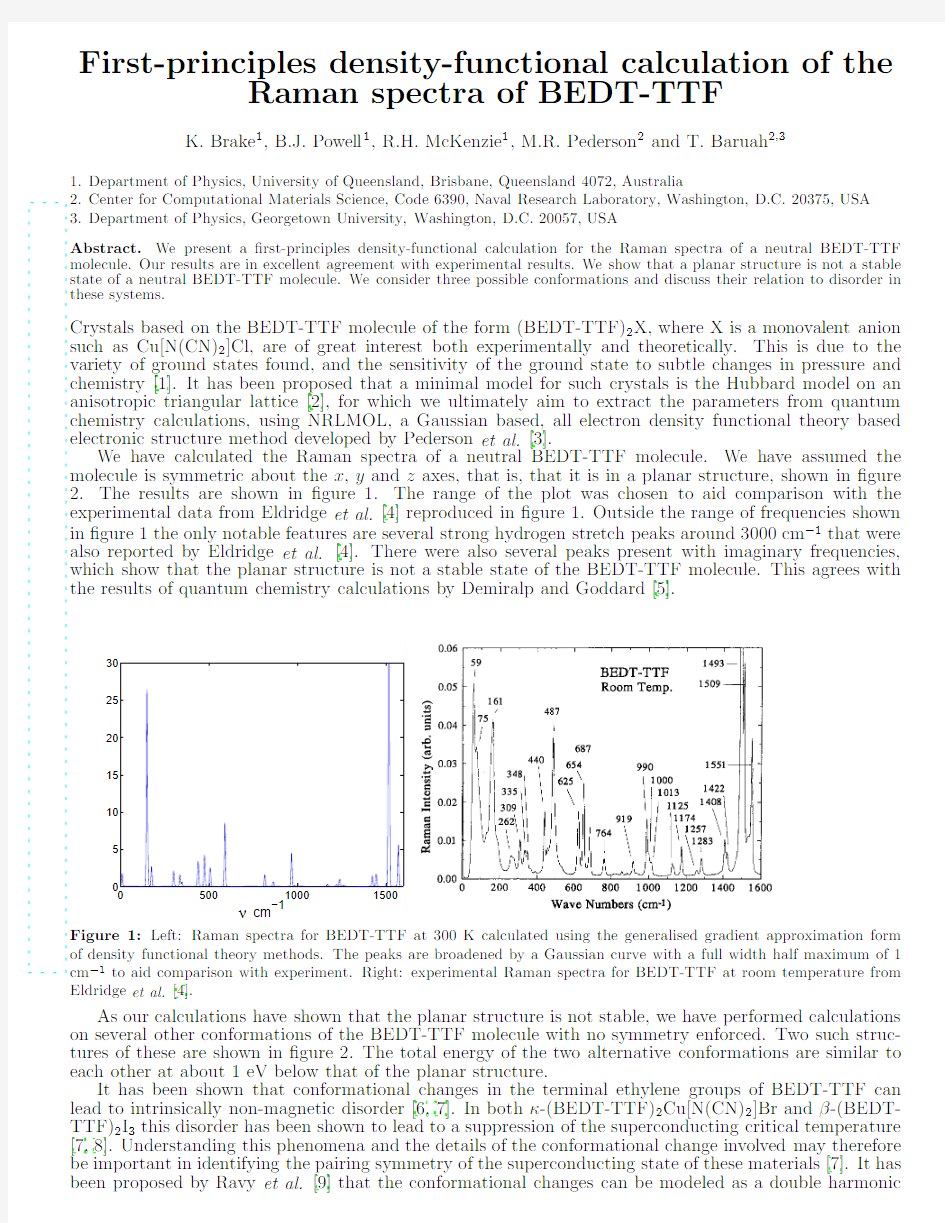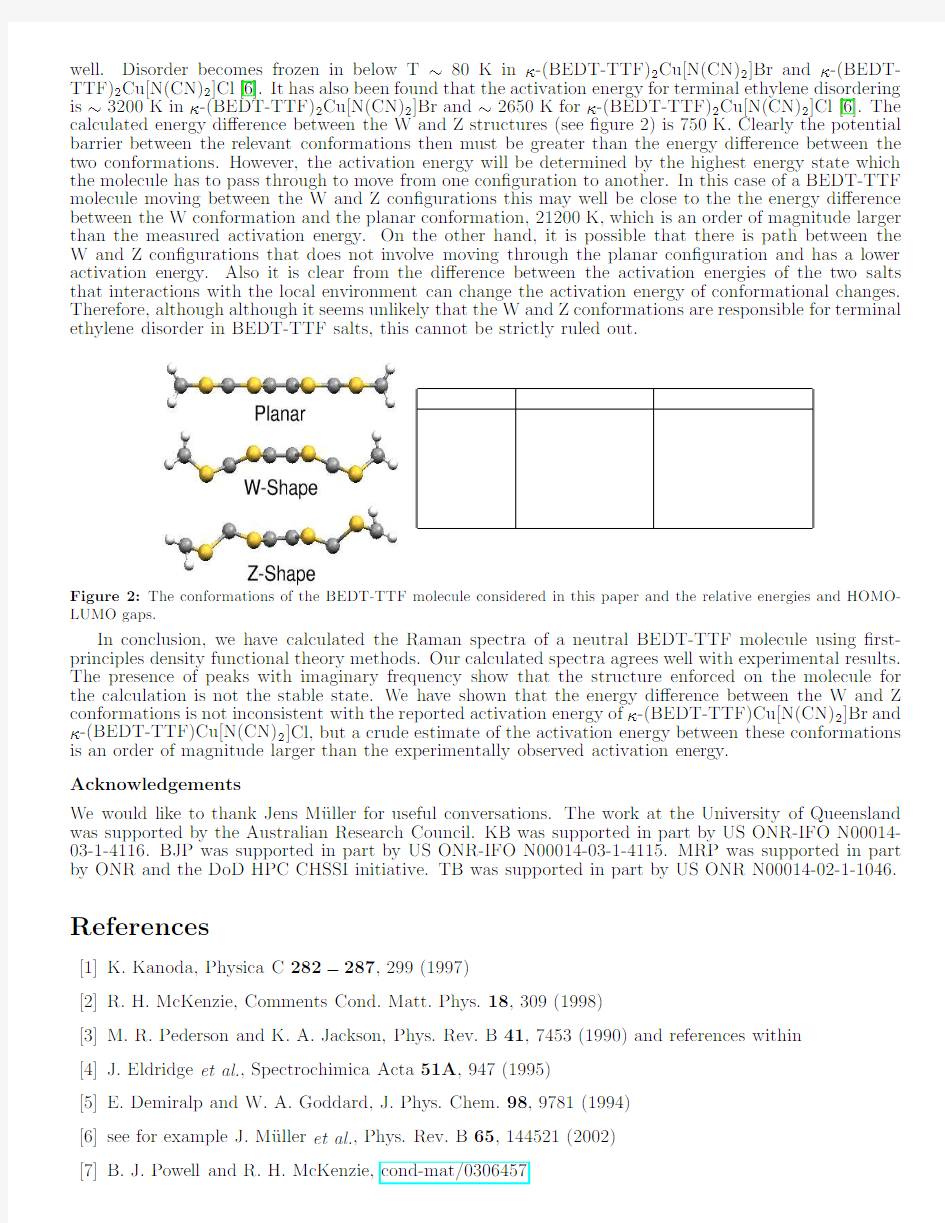First-principle density-functional calculation of the Raman spectra of BEDT-TTF


a r X i v :c o n d -m a t /0310197v 1 [c o n d -m a t .s u p r -c o n ] 9 O c t 2003First-principles density-functional calculation of the Raman spectra of BEDT-TTF
K.Brake 1,B.J.Powell 1,R.H.McKenzie 1,M.R.Pederson 2and T.Baruah 2,3
1.Department of Physics,University of Queensland,Brisbane,Queensland 4072,Australia
2.Center for Computational Materials Science,Code 6390,Naval Research Laboratory,Washington,D.C.20375,USA
3.Department of Physics,Georgetown University,Washington,D.C.20057,USA
Abstract.We present a ?rst-principles density-functional calculation for the Raman spectra of a neutral BEDT-TTF molecule.Our results are in excellent agreement with experimental results.We show that a planar structure is not a stable state of a neutral BEDT-TTF molecule.We consider three possible conformations and discuss their relation to disorder in these systems.
Crystals based on the BEDT-TTF molecule of the form (BEDT-TTF)2X,where X is a monovalent anion such as Cu[N(CN)2]Cl,are of great interest both experimentally and theoretically.This is due to the variety of ground states found,and the sensitivity of the ground state to subtle changes in pressure and chemistry [1].It has been proposed that a minimal model for such crystals is the Hubbard model on an anisotropic triangular lattice [2],for which we ultimately aim to extract the parameters from quantum chemistry calculations,using NRLMOL,a Gaussian based,all electron density functional theory based electronic structure method developed by Pederson et al.[3].We have calculated the Raman spectra of a neutral BEDT-TTF molecule.We have assumed the molecule is symmetric about the x ,y and z axes,that is,that it is in a planar structure,shown in ?gure 2.The results are shown in ?gure 1.The range of the plot was chosen to aid comparison with the experimental data from Eldridge et al.[4]reproduced in ?gure 1.Outside the range of frequencies shown in ?gure 1the only notable features are several strong hydrogen stretch peaks around 3000cm ?1that were also reported by Eldridge et al.[4].There were also several peaks present with imaginary frequencies,which show that the planar structure is not a stable state of the BEDT-TTF molecule.This agrees with the results of quantum chemistry calculations by Demiralp and Goddard [5].Figure 1:Left:Raman spectra for BEDT-TTF at 300K calculated using the generalised gradient approximation form of density functional theory methods.The peaks are broadened by a Gaussian curve with a full width half maximum of 1cm ?1to aid comparison with experiment.Right:experimental Raman spectra for BEDT-TTF at room temperature from Eldridge et al.[4].
As our calculations have shown that the planar structure is not stable,we have performed calculations on several other conformations of the BEDT-TTF molecule with no symmetry enforced.Two such struc-tures of these are shown in ?gure 2.The total energy of the two alternative conformations are similar to each other at about 1eV below that of the planar structure.It has been shown that conformational changes in the terminal ethylene groups of BEDT-TTF can lead to intrinsically non-magnetic disorder [6,7].In both κ-(BEDT-TTF)2Cu[N(CN)2]Br and β-(BEDT-TTF)2I 3this disorder has been shown to lead to a suppression of the superconducting critical temperature [7,8].Understanding this phenomena and the details of the conformational change involved may therefore be important in identifying the pairing symmetry of the superconducting state of these materials [7].It has been proposed by Ravy et al.[9]that the conformational changes can be modeled as a double harmonic
well.Disorder becomes frozen in below T~80K inκ-(BEDT-TTF)2Cu[N(CN)2]Br andκ-(BEDT-TTF)2Cu[N(CN)2]Cl[6].It has also been found that the activation energy for terminal ethylene disordering is~3200K inκ-(BEDT-TTF)2Cu[N(CN)2]Br and~2650K forκ-(BEDT-TTF)2Cu[N(CN)2]Cl[6].The calculated energy di?erence between the W and Z structures(see?gure2)is750K.Clearly the potential barrier between the relevant conformations then must be greater than the energy di?erence between the two conformations.However,the activation energy will be determined by the highest energy state which the molecule has to pass through to move from one con?guration to another.In this case of a BEDT-TTF molecule moving between the W and Z con?gurations this may well be close to the the energy di?erence between the W conformation and the planar conformation,21200K,which is an order of magnitude larger than the measured activation energy.On the other hand,it is possible that there is path between the W and Z con?gurations that does not involve moving through the planar con?guration and has a lower activation energy.Also it is clear from the di?erence between the activation energies of the two salts that interactions with the local environment can change the activation energy of conformational changes. Therefore,although although it seems unlikely that the W and Z conformations are responsible for terminal ethylene disorder in BEDT-TTF salts,this cannot be strictly ruled out.
Figure2:The conformations of the BEDT-TTF molecule considered in this paper and the relative energies and HOMO-LUMO gaps.
In conclusion,we have calculated the Raman spectra of a neutral BEDT-TTF molecule using?rst-principles density functional theory methods.Our calculated spectra agrees well with experimental results. The presence of peaks with imaginary frequency show that the structure enforced on the molecule for the calculation is not the stable state.We have shown that the energy di?erence between the W and Z conformations is not inconsistent with the reported activation energy ofκ-(BEDT-TTF)Cu[N(CN)2]Br and κ-(BEDT-TTF)Cu[N(CN)2]Cl,but a crude estimate of the activation energy between these conformations is an order of magnitude larger than the experimentally observed activation energy. Acknowledgements
We would like to thank Jens M¨u ller for useful conversations.The work at the University of Queensland was supported by the Australian Research Council.KB was supported in part by US ONR-IFO N00014-03-1-4116.BJP was supported in part by US ONR-IFO N00014-03-1-4115.MRP was supported in part by ONR and the DoD HPC CHSSI initiative.TB was supported in part by US ONR N00014-02-1-1046.
References
[1]K.Kanoda,Physica C282?287,299(1997)
[2]R.H.McKenzie,Comments Cond.Matt.Phys.18,309(1998)
[3]M.R.Pederson and K.A.Jackson,Phys.Rev.B41,7453(1990)and references within
[4]J.Eldridge et al.,Spectrochimica Acta51A,947(1995)
[5]E.Demiralp and W.A.Goddard,J.Phys.Chem.98,9781(1994)
[6]see for example J.M¨u ller et al.,Phys.Rev.B65,144521(2002)
[7]B.J.Powell and R.H.McKenzie,cond-mat/0306457
[8]B.J.Powell,cond-mat/0308565
[9]S.Ravy,R.Moret,and J.Pouget,Phys.Rev.B38,4469(1988)
